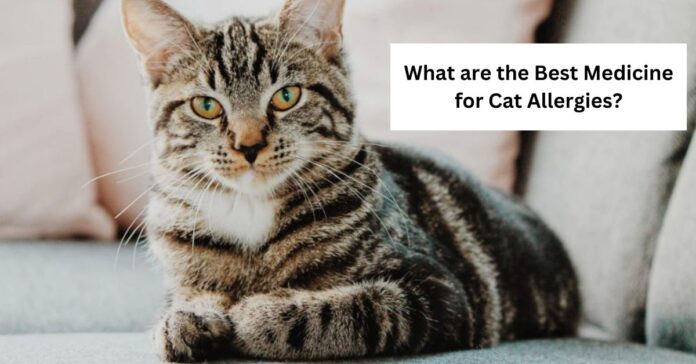About one-third of Americans who have allergies experience allergic reactions to cats and dogs. Dog allergies are half as common as cat allergies. Identifying the exact cause of your allergies can be challenging, especially when you have a pet living in your home. This is because homes also contain other allergens, such as dust mites, which can produce similar symptoms. It is crucial to consult an allergist to confirm whether you have a pet allergy.
Acknowledging that the cat you adore may be the cause of your health issues can be difficult. Many individuals prefer to tolerate the symptoms rather than part with their beloved pet. If you are determined to live with your furry friend, there are measures you can take to minimize allergy symptoms.
Continue reading to discover the medicine for cat allergies and learn how you can prevent them.
What are the Best Medicine for Cat Allergies?
When seeking relief for cat allergies, several effective medications can alleviate symptoms and improve quality of life. Antihistamines like cetirizine (Zyrtec), loratadine (Claritin), and fexofenadine (Allegra) are commonly recommended. They counteract histamine release, easing itching, sneezing, and runny nose. However, their efficacy can vary among individuals.
For more severe cases, nasal corticosteroid sprays such as fluticasone (Flonase) can provide significant relief by reducing inflammation in the nasal passages. This helps control congestion and sneezing. It’s essential to administer these under veterinary guidance, as improper use can lead to side effects.
In cases of persistent or severe allergies, allergen-specific immunotherapy (allergy shots) might be considered. This involves gradually exposing the cat to tiny amounts of the allergen, desensitising their immune system over time. Though a longer-term solution, it requires veterinary supervision and a commitment to the treatment schedule.
Remember, before administering any medication to a cat, consult a veterinarian. They can diagnose the allergy’s severity and recommend the most suitable treatment. Additionally, maintaining a clean living environment, frequent grooming, and providing proper nutrition can complement medication efforts in managing cat allergies effectively.
Causes
The development of allergies is influenced by genetic factors, indicating that having family members with allergies increases the likelihood of experiencing them.
Allergies occur when the immune system produces antibodies to combat substances that it perceives as harmful, such as bacteria and viruses. In individuals with allergies, the immune system mistakenly identifies an allergen as a threat and initiates the production of antibodies, leading to allergy symptoms like itching, a runny nose, skin rashes, and asthma.
In the case of cat allergies, allergens can originate from various sources, including your cat’s dander (dead skin cells), fur, saliva, and even urine. Inhalation of pet dander or direct contact with these allergens can trigger an allergic reaction. Pet allergen particles can adhere to clothing, float in the air, settle on furniture and bedding, and persist in the environment through dust particles.
Symptoms
Exposure to cat allergens is not limited to cat owners, as the allergen can be carried on people’s clothing. If your sensitivity to the allergen or the levels of allergens are low, cat allergies may not manifest for several days.
Typically, common signs of cat allergies occur shortly after coming into contact with cat dander, saliva, or urine. The primary cat allergen, to which over 90 percent of people with cat allergies react, is derived from cat saliva and skin. Male cats tend to have higher levels of this allergen, which is transferred to their fur during grooming. The allergen can cause swelling and itching of the membranes around the eyes and nose, often leading to eye inflammation and nasal congestion. Some individuals may develop a rash on their face, neck, or upper chest as a response to the allergen.
Untreated allergies can lead to fatigue and persistent coughing caused by postnasal drip. However, symptoms such as fevers, chills, nausea, or vomiting should be considered unrelated to allergies and more likely related to an illness.
In individuals with cat allergies, if cat allergens enter the lungs, they can interact with antibodies and trigger symptoms such as difficulty breathing, coughing, and wheezing. Cat allergies can even result in acute asthma attacks and act as triggers for chronic asthma.
Up to 30 percent of people with asthma can experience a severe attack when exposed to a cat. If your symptoms become disruptive or uncomfortable, it is important to discuss a treatment plan with your doctor.
Cat allergies are diagnosed
There are two primary methods to test for allergies, including cat allergies: skin testing and blood tests. Skin testing involves two types: the skin prick test and the intradermal skin test. Both of these tests provide rapid results and are typically more cost-effective than blood tests.
It is important to consult with your doctor to determine the most suitable test for you, as certain medications may interfere with skin testing. Due to the potential for severe reactions during testing, skin testing is usually conducted by an allergist.
Skin Prick Test
This test is performed in the doctor’s office under observation.
Using a sterile needle, the doctor will prick the surface of your skin, usually on the forearm or back, and apply a small amount of the allergen. Multiple allergens may be tested simultaneously. A control solution without allergens will also be used for comparison. Each prick may be numbered to identify the specific allergen.
Within 15 to 20 minutes, the skin prick site may exhibit redness or swelling if you are allergic to the substance. A positive reaction to the cat allergen will typically result in a red, itchy bump. These effects usually subside within 30 minutes after the test.
Intradermal Skin Testing
This test is also performed in the doctor’s office under observation.
Possible allergens are injected under the skin of the forearm or arm. A positive reaction will manifest as red, itchy bumps.
The intradermal test is considered more sensitive in detecting allergies compared to the skin prick test, meaning it may yield better positive results when an allergy exists. However, it can also lead to more false positives, causing a skin reaction even when there is no allergy.
Both skin tests play a role in allergy testing, and your doctor will explain which method is most appropriate for you.
Blood Test
In certain cases, individuals may not be suitable candidates for skin tests, such as those with existing skin conditions or young children who may find skin testing challenging. In such instances, a blood test is ordered. Blood is drawn either at the doctor’s office or a laboratory and sent for testing. The blood sample is examined for antibodies specific to common allergens, including cat dander. Although the results take longer to obtain, blood tests do not carry the risk of allergic reactions during the testing process.
Treatment for Cat Allergies
While the best approach is to avoid the allergen, in cases where complete avoidance is not possible, the following treatments may help alleviate cat allergy symptoms:
Antihistamines: Medications like diphenhydramine (Benadryl), loratadine (Claritin), or cetirizine (Zyrtec) can help reduce allergic reactions by blocking the effects of histamine.
Corticosteroid nasal sprays: Prescription corticosteroid nasal sprays like fluticasone (Flonase) or mometasone (Nasonex) can help relieve nasal congestion, inflammation, and other allergy symptoms.
Over-the-counter decongestant sprays: Non-prescription decongestant sprays can provide temporary relief from nasal congestion, but they should be used for short durations to avoid rebound congestion.
Cromolyn sodium: This medication prevents the release of immune system chemicals responsible for allergic reactions and may help reduce allergy symptoms.
Allergy shots (Immunotherapy): Immunotherapy involves a series of allergy shots that gradually desensitize the body to the specific allergen, such as cat dander. This treatment can help reduce the severity of allergic reactions over time.
Leukotriene inhibitors: Medications like montelukast (Singulair) can be prescribed to block the effects of leukotrienes, substances involved in the allergic response, and help alleviate symptoms.
Conclusion
In conclusion, finding the right medicine for cat allergies is crucial in ensuring the well-being and comfort of both the allergic individual and their feline companion. With options ranging from antihistamines like cetirizine and loratadine to nasal corticosteroid sprays such as fluticasone, there are effective solutions to alleviate symptoms such as itching, sneezing, and congestion. For more severe cases, allergen-specific immunotherapy offers a potential long-term strategy for managing allergies. However, it’s imperative to seek professional guidance from a veterinarian before administering any medication to a cat, as their unique needs and sensitivities must be considered. Alongside medication, maintaining a clean living environment, regular grooming, and a balanced diet can work synergistically to minimise allergic reactions. By taking a comprehensive approach to managing cat allergies, individuals can foster a healthier and more harmonious relationship with their beloved feline friends while promoting their own well-being.
FAQ
Q1: Are there hypoallergenic cat breeds?
Ans: Some cat breeds are considered hypoallergenic, but individual reactions can still vary.
Q2: Can I outgrow my cat allergies?
Ans: It is possible to outgrow cat allergies, but it varies from person to person.
Q3: How can I reduce cat allergens in my home?
Ans: Regularly vacuuming, using air purifiers, and keeping the cat out of bedrooms can help reduce allergen exposure.
Q4: Can allergy shots (immunotherapy) cure cat allergies?
Ans: Allergy shots can help alleviate symptoms and reduce sensitivity to cat allergens, but they may not provide a complete cure.








